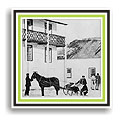 Heritage Community Foundation Presents
Heritage Community Foundation PresentsAlberta Online Encyclopedia
|
|
|
|
|
 |
|||
  |
Home | Information | Contact Us | Partners | Sitemap | Search |
|
|
|
|
|||
|
Home >> History and Evolution >> Volunteerism in Pre-1905 Alberta >> Settlement |
|||
|
Settlement - Page 1 |
|||
Page 1 | 2 Begun as trading and commercial hubs, Alberta’s first European-initiated communities were within fur trading forts and posts. For example in 1795, Fort Edmonton was originally built near the current location of Fort Saskatchewan, was relocated in 1802 to what is now downtown Edmonton, relocated between 1810 and 1813 to what is now the Rossdale Power Plant location, and then settled in 1830 on a site that is now part of Alberta’s Legislature grounds. 
Large forts had a small school room, missionaries who gave services, sleeping quarters for company men and their families, houses for factors, ice rooms, and garden plots. As time progressed, established fort locations spread outward and evolved into hamlets. 
Establishing Alberta’s earliest agricultural and faith communities outside fort or post locations came about largely through the efforts of missionaries who were intent on showing Native and Métis people that farming was in their best long- term interests — especially since the fur trade and ravaged buffalo herds could no longer provide livelihoods. Missions were built and crops were planted. For example in 1844, Father Thibault and Father Bourassa started a mission and planted crops in the Lac St. Anne area. Naturally, missions, grist mills, saw mills, obtaining livestock and planting crops could not be established without the volunteer work of the missionaries or the volunteer work of Native and Métis people. Father Lacombe arrived on the scene in 1852 and actively began promoting permanent farming areas for Métis people. In 1861, he built St. Albert mission by Sturgeon River. A Métis farming community grew around this log church. In 1872, the Dominion of Canada passed the Dominion Lands Act which gave settlers free land for homesteading. Farming, with a huge emphasis on a wheat crop economy was promoted. Under this Act, individuals could apply for parcels of Crown land in Western Canada. The size of most homesteads was one quarter section or 160 acres. Homesteaders were required to clear at least 10 acres of land, start some cultivation, build a habitable dwelling and some farm buildings, and live on the land for six months out of the year for three years. Once these various requirements were met, individual homesteaders could submit an application for title to the land. 
Aware of the beef bonanza that was occurring in the western United States, in 1879 the British government imposed an embargo on live cattle imported from the United States. Britain wanted to give Canadian cattlemen an advantage in the British market. The arrival of the railway in 1883 to Calgary and a focused shift from a wheat crop economy to ranching economy combined to change settlement patterns in Alberta. It was widely thought that southwestern Alberta was too dry for farming but possessed ideal conditions for large scale ranching. In 1881, the federal government amended the Dominion Lands Act that granted leases to British subjects. Only lessees could homestead. Huge incentives included up a hundred thousand acres (forty thousand hectares) for 21 years at a rate of $10 per thousand acres (four hundreds hectares) which is translated into one cent per acre per year. By 1881 nearly a thousand adventurous white men had lifted a corner of the curtain of Alberta’s stage and peered in expectantly. What they saw, whether along the Saskatchewan River or in the chinook belt was vastly encouraging. North of the coal along the Saskatchewan River lay unlimited forest; south of it, rich parklands. In the chinook belt, coal timber and rippling grasslands extended all along the foothills, while farther east, grazed only by deer antelope and gophers, stretched endless flower strewn, rolling pastures scented by wolf willow or sage. In short, they had peered into a land ready to flow with milk and honey. … |
|||
| [Top] [Back] | |||
| Copyright © 2004 Heritage Community Foundation All Rights Reserved | |||
 |
|||
|
|
|||
For more on volunteerism in alberta, visit Peel’s Prairie Provinces.
